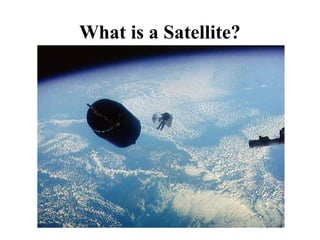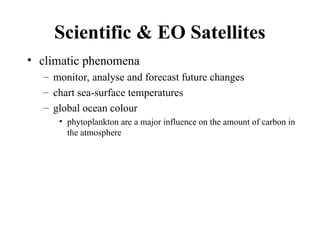Ad
Concepts of Satellite Communication and types and its applications
- 2. Learning Objectives: At the end of this topic you should be able to: describe satellite communications, give examples of typical applications of satellite communications. explain the advantages and disadvantages of satellite communications,
- 3. What is a Satellite? Meteosat weather satellite Weight: 2000kg
- 4. What is a Satellite?
- 5. What is a Satellite?
- 6. What is a Satellite?
- 7. • Satellites offer global coverage without wiring costs for base stations
- 8. What is a Satellite? • a satellite is any object that revolves around a planet • there are many manmade (artificial) satellites, – ~13,000 satellites are tracked in real time • some are inactive, some are debris from space missions … • the path a satellite follows is called an orbit, • to access a satellite requires ‘line of sight’ communication – the receiver (satellite dish) must be in the satellite’s ‘footprint’ • most satellites are custom built to perform a function.
- 9. What are satellites used for? • television broadcasting – satellite TV (e.g. Sky) • telephone communications, – satellite ‘phones (e.g. “Iridium”) • weather forecasting, – satellite images (visible, infra red, radar) • Internet communications, • scientific research, – climate monitoring, global disaster monitoring, …. • Global Positioning System – GPS satellite navigation (‘SatNav’) – satellite tracking, security • Military satellites
- 10. 5.10 base station or gateway Classical satellite systems Inter Satellite Link (ISL) Mobile User Link (MUL) Gateway Link (GWL) footprint small cells (spotbeams) User data PSTN ISDN GSM GWL MUL PSTN: Public Switched Telephone Network
- 11. satellites footprint (coverage) • The area of the Earth covered by the microwave radiation from a satellite dish (transponder) is called the satellites footprint. • Each satellite can cover a certain area on the earth with its beam (the so-called ‘footprint’
- 13. Basics • Satellites in circular orbits – attractive force Fg = m g (R/r)² – centrifugal force Fc = m r ² – m: mass of the satellite – R: radius of the earth (R = 6370 km) – r: distance to the center of the earth – g: acceleration of gravity (g = 9.81 m/s²) : angular velocity ( = 2 f, f: rotation frequency) • Stable orbit – Fg = Fc 3 2 2 ) 2 ( f gR r Satellites orbit around the earth. Depending on the application, these orbits can be circular or elliptical. Satellites in circular orbits always keep the same distance
- 14. 5.14 Basics elliptical or circular orbits complete rotation time depends on distance satellite-earth inclination: angle between orbit and equator elevation: angle between satellite and horizon LOS (Line of Sight) to the satellite necessary for connection high elevation needed, less absorption due to e.g. buildings Uplink: connection base station - satellite Downlink: connection satellite - base station typically separated frequencies for uplink and downlink
- 15. 5.15 Inclination inclination satellite orbit perigee plane of satellite orbit equatorial plane
- 16. 5.16 Elevation Elevation: angle between center of satellite beam and surface minimal elevation: levation needed at least o communicate with the satellite footprint
- 17. 5.17 • Four different types of satellite orbits can be identified depending on the shape and diameter of the orbit: GEO: geostationary orbit, ca. 36000 km above earth surface LEO (Low Earth Orbit): ca. 500 - 1500 km MEO (Medium Earth Orbit) or ICO (Intermediate Circular Orbit): ca. 6000 - 20000 km HEO (Highly Elliptical Orbit) elliptical orbits Orbits
- 18. 5.18 Orbits earth km 35768 10000 1000 LEO (Globalstar, Irdium) HEO inner and outer Van Allen belts MEO (ICO) GEO (Inmarsat) Van-Allen-Belts: ionized particles 2000 - 6000 km and 15000 - 30000 km above earth surface
- 19. Parameters in satellite communication
- 20. How does Satellite Communications work? Generally: • there is a transmitter on the ground • the transmitter sends signals to a satellite – using microwaves • signal is received & amplified by the satellite • signal is retransmitted back to Earth • signal reaches its recipient – or is 'bounced back' to another satellite
- 21. Satellite Launch
- 22. Satellite Launch
- 25. GCHQ Satellite Ground station
- 27. Where are these satellites? There are 2 main types of satellite orbit: • Geostationary orbit – always positioned over the same spot on Earth – orbit at 22,000 miles (36,000 km) • Low Earth Orbit (LEO) – orbit at 400-800km
- 29. Geostationary Satellite • always positioned over the same spot on Earth • orbits at the same rotational speed as the Earth – approx 10,000 km/h • orbits 22,000 miles (36,000 km) above the Earth, – about a tenth of the distance to the Moon • able to capture images of the whole Earth disc • used by TV and weather satellites – this is why a satellite TV dish is bolted in a fixed position.
- 32. LEO Satellites • much closer to Earth than a geostationary orbit, – orbit at 400-800km (aircraft fly at 11km, ISS ~300km), – orbit at ~27,000 km/h (17,000 mph) – each orbit takes ~ 90mins, • has a smaller footprint than a geostationary satellite – can resolve finer detail (optical resolution ~40cm in 2010) • usually employ a group of satellites, – each in the same orbit, – at least one satellite is visible at any time, • possible to access satellites from any point on Earth, – GPS & satellite navigation (‘Navstar’) – use satellite ‘phone in remote locations (‘Iridium’ satellites), – global Internet access.
- 33. LEO Satellites
- 34. Advantages of Satellite Communication • can reach remote places – so people can be contacted wherever they are • e.g. areas where there is no cellular/fixed line connection • high bandwidth – many simultaneous calls can take place – video & audio can be transmitted in real time • cost of communication is distance independent – whether message is sent 10 km or 6000 km
- 35. Disadvantages of using Satellites • are expensive to set up and maintain • needs line of sight – can lose signal out of footprint or in built up areas • affected by weather conditions/interference – leading to signal degradation • distance from Earth – means messages takes time – can cause unacceptable delay on communications • general congestion in space – limitation on number of satellites in geostationary orbit
- 36. Uses for Satellite • Weather satellites • Communications satellites • Scientific satellites • Navigational satellites • Earth observation satellites • Military satellites
- 37. Weather Satellite • can see what's happening at the moment.
- 38. Weather Satellite • can see what's happening at the moment. • help meteorologists predict the weather
- 39. Weather Satellite • can see what's happening at the moment. • help meteorologists predict the weather • typical weather satellites include the Meteosat, GOES and NOAA satellites.
- 40. Weather Satellite • can see what's happening at the moment. • help meteorologists predict the weather • typical weather satellites include the Meteosat, GOES and NOAA satellites. • satellites generally contain cameras that can return photos of Earth's weather,
- 41. Weather Satellite • can see what's happening at the moment. • help meteorologists predict the weather • typical weather satellites include the Meteosat, GOES and NOAA satellites. • satellites generally contain cameras that can return photos of Earth's weather, • use visible and infra red imaging
- 42. Weather Satellite • can see what's happening at the moment. • help meteorologists predict the weather • typical weather satellites include the Meteosat, GOES and NOAA satellites. • satellites generally contain cameras that can return photos of Earth's weather, • use visible and infra red imaging • use either geostationary positions or polar orbits.
- 46. Weather Satellite Hurricane Katrina (August 2005)
- 47. Weather Satellite Hurricane Katrina (August 2005)
- 48. Scientific & EO Satellites • climatic phenomena
- 49. Scientific & EO Satellites • climatic phenomena – monitor, analyse and forecast future changes
- 50. Scientific & EO Satellites • climatic phenomena – monitor, analyse and forecast future changes – chart sea-surface temperatures
- 51. Scientific & EO Satellites • climatic phenomena – monitor, analyse and forecast future changes – chart sea-surface temperatures – global ocean colour • phytoplankton are a major influence on the amount of carbon in the atmosphere
- 52. Scientific & EO Satellites • climatic phenomena – monitor, analyse and forecast future changes – chart sea-surface temperatures – global ocean colour • phytoplankton are a major influence on the amount of carbon in the atmosphere • NASA monitors lake and reservoir height variations for approximately 100 lakes
- 53. Scientific & EO Satellites • climatic phenomena – monitor, analyse and forecast future changes – chart sea-surface temperatures – global ocean colour • phytoplankton are a major influence on the amount of carbon in the atmosphere • NASA monitors lake and reservoir height variations for approximately 100 lakes • track natural events in progress, – fires, floods, volcanic eruptions
- 54. Scientific & EO Satellites • climatic phenomena – monitor, analyse and forecast future changes – chart sea-surface temperatures – global ocean colour • phytoplankton are a major influence on the amount of carbon in the atmosphere • NASA monitors lake and reservoir height variations for approximately 100 lakes • track natural events in progress, – fires, floods, volcanic eruptions • deforestation
- 55. Scientific & EO Satellites • climatic phenomena – monitor, analyse and forecast future changes – chart sea-surface temperatures – global ocean colour • phytoplankton are a major influence on the amount of carbon in the atmosphere • NASA monitors lake and reservoir height variations for approximately 100 lakes • track natural events in progress, – fires, floods, volcanic eruptions • deforestation • astrophysical observations - Hubble Space Telescope
- 56. Scientific & EO Satellites 1975 1985 1992 Deforestation in Brazil
- 57. Scientific & EO Satellites 1975 1992 2006 Deforestation in Brazil http://earthobservatory.nasa.gov/IOTD/view.php?id=35891
- 58. Scientific & EO Satellites Mineral Exploration Image displays the mineral abundance layer. Red = Mica, Cyan/Green= Kaolinite, Blue= Alunite, Beige = Carbonate, Brown = Silica, Mauve = Iron
- 59. Scientific & EO Satellites Volcano Explosion on Montserrat (1997)
- 60. Scientific & EO Satellites Dust Storms off the Sahara
- 61. Scientific & EO Satellites UK cities in IR
- 62. Military Satellites • applications may include: – relaying encrypted communications – nuclear monitoring – observing enemy movements – early warning of missile launches – eavesdropping on terrestrial radio links – radar imaging – photography • using what are essentially large telescopes that take pictures of militarily interesting areas
- 63. Military Satellites Washington Airport (1 pixel = 0.6m)
- 64. Military Satellites Baghdad during 2nd Gulf War
- 65. Communications Satellites • usually in geosynchronous orbit – serve a particular area of the Earth – can use a cellular network of satellites • serve the whole Earth • allow telephone and data conversations to be relayed through the satellite – Internet, email, satellite ‘phone, TV – can broadcast television signals from one point on Earth to another • normally contain thousands of transponders – many simultaneous users




































































































































